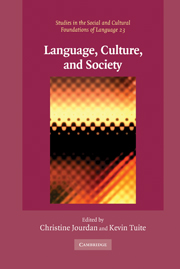Book contents
- Frontmatter
- Contents
- List of tables
- List of contributors
- Acknowledgments
- Introduction: Walking through walls
- 1 An issue about language
- 2 Linguistic relativities
- 3 Benjamin Lee Whorf and the Boasian foundations of contemporary ethnolinguistics
- 4 Cognitive anthropology
- 5 Methodological issues in cross-language color naming
- 6 Pidgins and creoles genesis: an anthropological offering
- 7 Bilingualism
- 8 The impact of language socialization on grammatical development
- 9 Intimate grammars: anthropological and psychoanalytic accounts of language, gender, and desire
- 10 Maximizing ethnopoetics: fine-tuning anthropological experience
- 11 Interpreting language variation and change
- References
- Index
- STUDIES IN THE SOCIAL AND CULTURAL FOUNDATIONS OF LANGUAGE
10 - Maximizing ethnopoetics: fine-tuning anthropological experience
Published online by Cambridge University Press: 16 November 2009
- Frontmatter
- Contents
- List of tables
- List of contributors
- Acknowledgments
- Introduction: Walking through walls
- 1 An issue about language
- 2 Linguistic relativities
- 3 Benjamin Lee Whorf and the Boasian foundations of contemporary ethnolinguistics
- 4 Cognitive anthropology
- 5 Methodological issues in cross-language color naming
- 6 Pidgins and creoles genesis: an anthropological offering
- 7 Bilingualism
- 8 The impact of language socialization on grammatical development
- 9 Intimate grammars: anthropological and psychoanalytic accounts of language, gender, and desire
- 10 Maximizing ethnopoetics: fine-tuning anthropological experience
- 11 Interpreting language variation and change
- References
- Index
- STUDIES IN THE SOCIAL AND CULTURAL FOUNDATIONS OF LANGUAGE
Summary
Ethnopoetics was coined if not defined by Jerome Rothenberg, Dennis Tedlock and their friends in 1967. Seeking to expand and advance the concept and its descendants, the word will be taken to mean, not just the intersection of poetry and anthropology, but the study and the creation of relations and interactions between three phenomena: first, poetic language in the largest sense, from self-conscious lyric to a political speech to the latent figures in any verbal communication – even a recipe for apple pie; second, a social group with its ethnicity and culture, ranging from a Tamil family to the Hatfield and McCoy clans to France to groups of ethnically defined nations – the Caucasus, China; the third phenomenon is the individual making the connection between the first two through his poetry or language in general: poet, orator, ethnopoetician, Everyman (always uniquely creative by definition).
Before launching into the map below with its road signs, let me state right off the gist of this chapter in simple terms. It runs from writing poems and doing translations that involve, in particular, distant and different worlds, to the analysis of poetic matter in terms of linguistics and anthropology, specifically ethnography. I then turn to several general questions, including theory in ethnopoetics and some possible relations between ethnopoetic and anthropological theory, and theory in other fields.
- Type
- Chapter
- Information
- Language, Culture, and SocietyKey Topics in Linguistic Anthropology, pp. 207 - 228Publisher: Cambridge University PressPrint publication year: 2006
- 13
- Cited by



